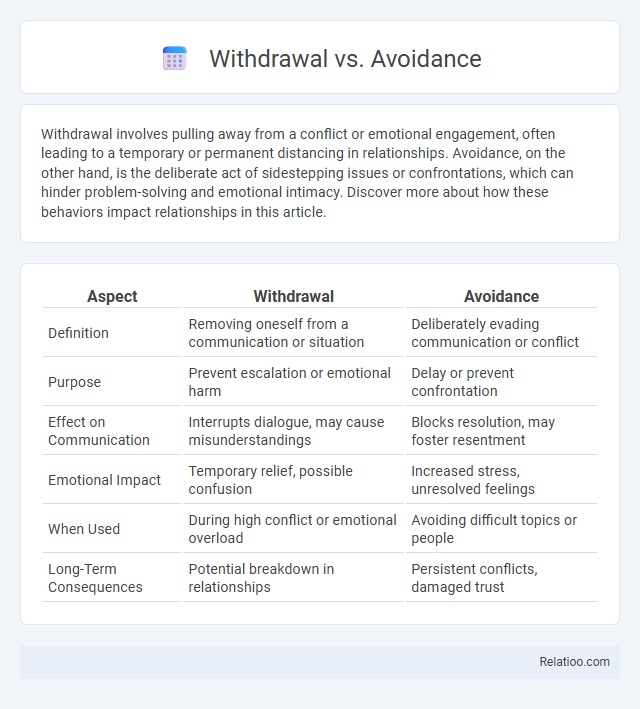Withdrawal involves pulling away from a conflict or emotional engagement, often leading to a temporary or permanent distancing in relationships. Avoidance, on the other hand, is the deliberate act of sidestepping issues or confrontations, which can hinder problem-solving and emotional intimacy. Discover more about how these behaviors impact relationships in this article.
Table of Comparison
| Aspect | Withdrawal | Avoidance |
|---|---|---|
| Definition | Removing oneself from a communication or situation | Deliberately evading communication or conflict |
| Purpose | Prevent escalation or emotional harm | Delay or prevent confrontation |
| Effect on Communication | Interrupts dialogue, may cause misunderstandings | Blocks resolution, may foster resentment |
| Emotional Impact | Temporary relief, possible confusion | Increased stress, unresolved feelings |
| When Used | During high conflict or emotional overload | Avoiding difficult topics or people |
| Long-Term Consequences | Potential breakdown in relationships | Persistent conflicts, damaged trust |
Understanding Withdrawal and Avoidance
Understanding withdrawal involves recognizing it as a conscious or unconscious retreat from situations causing stress or discomfort, which can impact emotional well-being. Avoidance differs by actively steering clear of specific triggers or challenges, often leading to limited coping skill development and increased anxiety over time. Your awareness of these behaviors helps in addressing the root causes and promotes healthier emotional responses and coping strategies.
Defining Withdrawal: Key Features
Withdrawal involves physically or emotionally distancing yourself from a situation or person, often as a response to stress or conflict, characterized by reduced communication and interaction. Unlike avoidance, which is a preventive action to steer clear of potential issues, withdrawal happens after engagement has occurred, marked by retreat and disengagement. Your awareness of these differences helps in managing relationships and mental health by recognizing when to address problems or when to seek space.
What Is Avoidance? Core Concepts
Avoidance is a psychological defense mechanism where individuals deliberately evade uncomfortable thoughts, feelings, or situations to reduce anxiety or distress. Unlike withdrawal, which involves retreating physically or emotionally, avoidance specifically targets the suppression or sidestepping of stress-inducing stimuli or conflicts. Understanding avoidance is crucial in cognitive-behavioral therapy as it highlights patterns that can perpetuate anxiety disorders and hinder emotional growth.
Psychological Roots: Withdrawal vs Avoidance
Withdrawal and avoidance both stem from psychological defense mechanisms, but they differ in motivation and manifestation. Withdrawal involves retreating inward to escape stress or emotional pain, often linked to feelings of helplessness or fear of confrontation. Avoidance centers on deliberately steering clear of specific situations or stimuli to prevent anxiety or discomfort, reflecting an anticipatory coping strategy rooted in fear or trauma.
Behavioral Signs of Withdrawal
Behavioral signs of withdrawal include increased irritability, restlessness, and intense cravings as the body reacts to the absence of a substance. Avoidance behavior often manifests as deliberately steering clear of triggers or situations associated with substance use to prevent relapse. Withdrawal differs from avoidance in that it involves physical and psychological symptoms arising directly from cessation, while avoidance is a coping strategy to manage these symptoms and reduce exposure to temptation.
Behavioral Signs of Avoidance
Behavioral signs of avoidance include evading specific places, people, or situations that cause discomfort or anxiety, often manifesting as procrastination or refusal to engage in certain activities. Withdrawal, by contrast, involves retreating inwardly, showing reduced social interaction and diminished emotional responsiveness. Avoidance behaviors directly impact daily functioning by limiting exposure to stressors, whereas withdrawal typically reflects a broader disengagement from social and environmental stimuli.
Emotional Impact: Comparing Effects
Withdrawal often leads to increased feelings of isolation and sadness, deeply affecting your emotional well-being. Avoidance temporarily reduces anxiety but can perpetuate stress and prevent emotional growth. Comparing effects reveals that while withdrawal amplifies negative emotions, avoidance delays resolution and long-term emotional healing.
Triggers and Causes: Withdrawal vs Avoidance
Withdrawal often results from internal triggers such as anxiety, fear, or emotional distress, leading individuals to retreat from social or stressful situations. Avoidance tends to be a behavior driven by external triggers or anticipated negative outcomes, where individuals actively evade specific tasks, people, or environments to reduce discomfort. Both withdrawal and avoidance serve as coping mechanisms but differ in their reactive versus proactive nature, with withdrawal being a passive retreat and avoidance an active evasion.
Coping Strategies and Interventions
Withdrawal, avoidance, and withdrawal as coping strategies each involve different psychological responses to stress or threats. Withdrawal typically refers to physically or emotionally retreating from a stressful situation, often to reduce immediate anxiety but may lead to social isolation if prolonged. Avoidance involves deliberately steering clear of specific stressors or triggers, which can provide short-term relief but might hinder problem-solving and adaptation, while interventions such as cognitive-behavioral therapy (CBT) focus on addressing these patterns by promoting proactive engagement and healthier coping mechanisms.
Choosing the Best Approach: Managing Withdrawal and Avoidance
Effective management of withdrawal and avoidance behaviors relies on distinguishing between the two to select the best approach tailored to individual needs. Withdrawal often requires gradual exposure and support to reintegrate individuals into challenging situations, while avoidance is managed through cognitive-behavioral strategies that confront and reduce fear triggers. Integrating personalized therapy plans and behavioral interventions maximizes success in overcoming both withdrawal and avoidance tendencies.

Infographic: Withdrawal vs Avoidance
 relatioo.com
relatioo.com